Enhancement of Image Quality in LCD by Doping γ-Fe2O3 Nanoparticles and Reducing Friction Torque Difference
Abstract
1. Introduction
2. Experimental
2.1. Liquid Crystal (LC) Materials
2.2. Measurement of LC Cells
2.3. Physics Properties
2.4. Evaluation of Residual Direct Current (DC) Voltage
2.5. Dynamic Response
3. Results and Discussion
3.1. Physics Properties of LCs
3.2. Determination of Image Sticking
3.3. Effect and Mechanism of Doping γ-Fe2O3 Nanoparticles
3.4. Residual Characteristics of Friction Torque Difference
4. Conclusions
Author Contributions
Funding
Conflicts of Interest
References
- Yang, D.K.; Wu, S.T. Fundamentals of Liquid Crystal Devices; John Wiley & Sons, Ltd.: Chichester, UK, 2006. [Google Scholar]
- Pauluth, D.; Tarumi, K. Advanced liquid crystals for television. J. Mater. Chem. 2004, 14, 1219–1227. [Google Scholar] [CrossRef]
- Kim, T.; Lee, J.H.; Yoon, T.H.; Choi, S.W. Reflective dual-mode liquid crystal display possessing low power consumption and high contrast ratio under ambient light. Opt. Express 2012, 20, 15522–15529. [Google Scholar] [CrossRef] [PubMed]
- Yun, H.J.; Jo, M.H.; Jang, I.W.; Lee, S.H.; Ahn, S.H.; Hur, H.J. Achieving high light efficiency and fast response time in fringe field switching mode using a liquid crystal with negative dielectric anisotropy. Liq. Cryst. 2012, 39, 1141–1148. [Google Scholar] [CrossRef]
- Jeong, E.; Lim, Y.J.; Rhee, J.M.; Lee, S.H. Viewing angle switching of vertical alignment liquid crystal displays by controlling birefringence of homogenously aligned liquid crystal layer. Appl. Phys. Lett. 2007, 90, 051116. [Google Scholar] [CrossRef]
- Tsutsui, K.; Sakai, T.; Goto, K.; Sawahata, K.; Ishikawa, M.; Fukuro, H. An Image Sticking-Free Novel Alignment Material for IPS-LCD. SID Int. Symp. Dig. Tech. Pap. 2003, 34, 1166–1169. [Google Scholar] [CrossRef]
- Momoi, Y.; Tamai, K.; Furuta, K.; Lee, T.R.; Kim, K.J.; Oh, C.H. Mechanism of image sticking after long-term ac field driving of IPS mode. J. Soc. Inf. Disp. 2012, 18, 134–140. [Google Scholar] [CrossRef]
- Mizusaki, M.; Miyashita, T.; Uchida, T.; Yamada, Y.; Ishii, Y. The Mechanism of Image Sticking on LCD and its Evaluation Parameters Related to LC and Alignment Materials. SID Int. Symp. Dig. Tech. Pap. 2006, 37, 673–676. [Google Scholar] [CrossRef]
- Mizusaki, M.; Miyashita, T.; Uchida, T. Behavior of ion affecting image sticking on liquid crystal displays under application of direct current voltage. J. Appl. Phys. 2010, 108, 104903. [Google Scholar] [CrossRef]
- Xu, D.M.; Peng, F.L.; Chen, H.W.; Yuan, J.; Wu, S.T.; Li, M.C. Image sticking in liquid crystal displays with lateral electric fields. J. Appl. Phys. 2014, 116, 305–396. [Google Scholar] [CrossRef]
- Mizusaki, M.; Miyashita, T.; Uchida, T. Kinetic analysis of image sticking with adsorption and desorption of ions to a surface of an alignment layer. J. Appl. Phys. 2012, 112, 044510. [Google Scholar] [CrossRef]
- Mizusaki, M.; Miyashita, T.; Uchida, T.; Yamada, Y. Generation mechanism of residual direct current voltage in a liquid crystal display and its evaluation parameters related to liquid crystal and alignment layer materials. J. Appl. Phys. 2007, 102, 014904. [Google Scholar] [CrossRef]
- Urbanski, M.; Lagerwall, J.P.F. Why organically functionalized nanoparticles increase the electrical conductivity of nematic liquid crystal dispersions. J. Mater. Chem. 2017, 5, 8802–8809. [Google Scholar] [CrossRef]
- Jian, B.R.; Tang, C.Y.; Wei, L. Temperature-dependent electrical properties of dilute suspensions of carbon nanotubes in nematic liquid crystals. Carbon 2011, 49, 910–914. [Google Scholar] [CrossRef]
- Saliba, S.; Mingotaud, C.; Kahn, M.L.; Marty, J.D. Liquid crystalline thermotropic and lyotropic nanohybrids. Nanoscale 2013, 5, 6641–6661. [Google Scholar] [CrossRef] [PubMed]
- Dierking, I.; Scalia, G.; Morales, P.; Leclere, D. Aligning and reorienting carbon nanotubes with nematic liquid crystals. Adv. Mater. 2004, 16, 865–869. [Google Scholar] [CrossRef]
- Zhao, D.Y.; Zhou, W.; Cui, X.P.; Tian, Y.; Guo, L.; Yang, H. Alignment of Liquid Crystals Doped with Nickel Nanoparticles Containing Different Morphologies. Adv. Mater. 2011, 23, 5779–5784. [Google Scholar] [CrossRef] [PubMed]
- Podgornov, F.V.; Suvorova, A.M.; Lapanik, A.V.; Haase, W. Electrooptic and dielectric properties of ferroelectric liquid crystal/single walled carbon nanotubes dispersions confined in thin cells. Chem. Phys. Lett. 2009, 479, 206–210. [Google Scholar] [CrossRef]
- Ha, Y.S.; Kim, H.J.; Park, H.G.; Seo, D.S. Enhancement of electro-optic properties in liquid crystal devices via titanium nanoparticle doping. Opt. Express 2012, 20, 6448–6455. [Google Scholar] [CrossRef] [PubMed]
- Garbovskiy, Y. Nanoparticle-Enabled Ion Trapping and Ion Generation in Liquid Crystals. Adv. Cond. Matter. Phys. 2018, 8914891. [Google Scholar] [CrossRef]
- Shcherbinin, D.P.; Konshina, E.A. Impact of titanium dioxide nanoparticles on purification and contamination of nematic liquid crystals. Beil. J. Nano 2017, 8, 2766–2770. [Google Scholar] [CrossRef] [PubMed]
- Garbovskiy, Y. Nanomaterials in Liquid Crystals as Ion-Generating and Ion-Capturing Objects. Crystals 2018, 8, 264. [Google Scholar] [CrossRef]
- Garbovskiy, Y.; Glushchenko, I. Nano-Objects and Ions in Liquid Crystals: Ion Trapping Effect and Related Phenomena. Crystals 2015, 5, 501–533. [Google Scholar] [CrossRef]
- Ye, W.J.; Yuan, R.; Dai, Y.Y.; Gao, L.; Pang, Z.; Zhu, J.L.; Meng, X.S.; He, Z.H.; Li, J.; Cai, M.L.; et al. Improvement of image sticking in liquid crystal display doped with γ-Fe2O3 nanoparticles. Nanomaterials 2018, 8, 5. [Google Scholar] [CrossRef] [PubMed]
- Chen, P.S.; Huang, C.C.; Liu, Y.W.; Chao, C.Y. Effect of insulating-nanoparticles addition on ion current and voltage-holding ratio in nematic liquid crystal cells. Appl. Phys. Lett. 2007, 90, 211111. [Google Scholar] [CrossRef]
- Yadav, S.P.; Manohar, R.; Singh, S. Effect of TiO2 nanoparticles dispersion on ionic behaviour in nematic liquid crystal. Liq. Cryst. 2015, 42, 1095–1101. [Google Scholar] [CrossRef]
- Garbovskiy, Y. Ion capturing/ion releasing films and nanoparticles in liquid crystal devices. Appl. Phys. Lett. 2017, 110, 041103. [Google Scholar] [CrossRef]
- Garbovskiy, Y. Kinetics of Ion-Capturing/Ion-Releasing Processes in Liquid Crystal Devices Utilizing Contaminated Nanoparticles and Alignment Films. Nanomaterials. 2018, 8, 59. [Google Scholar] [CrossRef] [PubMed]
- Garbovskiy, Y. Ions and size effects in nanoparticle/liquid crystal colloids sandwiched between two substrates. The case of two types of fully ionized species. Chem. Phys. Lett. 2017, 679, 77–85. [Google Scholar] [CrossRef]
- Garbovskiy, Y. Impact of contaminated nanoparticles on the non-monotonous change in the concentration of mobile ions in liquid crystals. Liq. Cryst. 2016, 43, 664–670. [Google Scholar] [CrossRef]
- Lee, T.R.; Jin, H.K.; Lee, S.H.; Jun, M.C.; Hong, K.B. Investigation on newly designed low resistivity polyimide-type alignment layer for reducing DC image sticking of in-plane switching liquid crystal display. Liq. Cryst. 2016, 44, 738–747. [Google Scholar] [CrossRef]
- Mizusaki, M.; Nakanishi, Y. Improvement of image sticking on liquid crystal displays with polymer layers produced from mixed monomers. Liq. Cryst. 2016, 43, 704–710. [Google Scholar] [CrossRef]
- Nakanishi, Y.; Hanaoka, K.; Shibasaki, M.; Okamoto, K. Relation between monomer structure and image sticking phenomenon of polymer-sustained-alignment liquid crystal displays. Appl. Spectrosc. 2011, 50, 051702. [Google Scholar]
- Wen, B.C.; Li, J.; Lin, Y.Q.; Liu, X.D.; Fu, J.; Miao, H.; Zhang, Q.M. A novel preparation method for γ-Fe2O3 nanoparticles and their characterization. Mater. Chem. Phys. 2011, 128, 35–38. [Google Scholar] [CrossRef]
- Chen, Y.S.; Chen, Q.; Mao, H.; Zhang, T.; Qiu, X.Y.; Lin, Y.Q.; Li, J. Preparation of magnetic nanoparticles via chemically induced transition: Dependence of components and magnetization on the concentration of treating solution used. Nanomater. Nanotechnol. 2017, 7, 1–9. [Google Scholar] [CrossRef]
- Zhang, T.; Meng, X.S.; He, Z.H.; Lin, Y.Q.; Liu, X.D.; Li, D.C.; Li, J.; Qiu, X.Y. Preparation of magnetic nanoparticles via chemically induced transition: Role of treating solution’s temperature. Nanomaterials 2017, 7, 220. [Google Scholar] [CrossRef] [PubMed]
- Ye, W.J.; Li, Z.J.; Yuan, R.; Zhang, P.; Sun, T.T.; Cai, M.L.; Wang, X.Y.; Zhu, J.L.; Sun, Y.B.; Xing, H.Y. Accurate measurement of the twist elastic constant of liquid crystal by using capacitance. Liq. Cryst. 2018. [Google Scholar] [CrossRef]
- Ke, J.C.; Chung, T.C.; Liao, C.T.; Yu, C.M.; Qiao, Y.B. A Systematic Research of Image Sticking in Fringe Field Switching Liquid Crystal Displays. SID Int. Symp. Dig. Tech. Pap. 2018, 47, 1707–1710. [Google Scholar] [CrossRef]

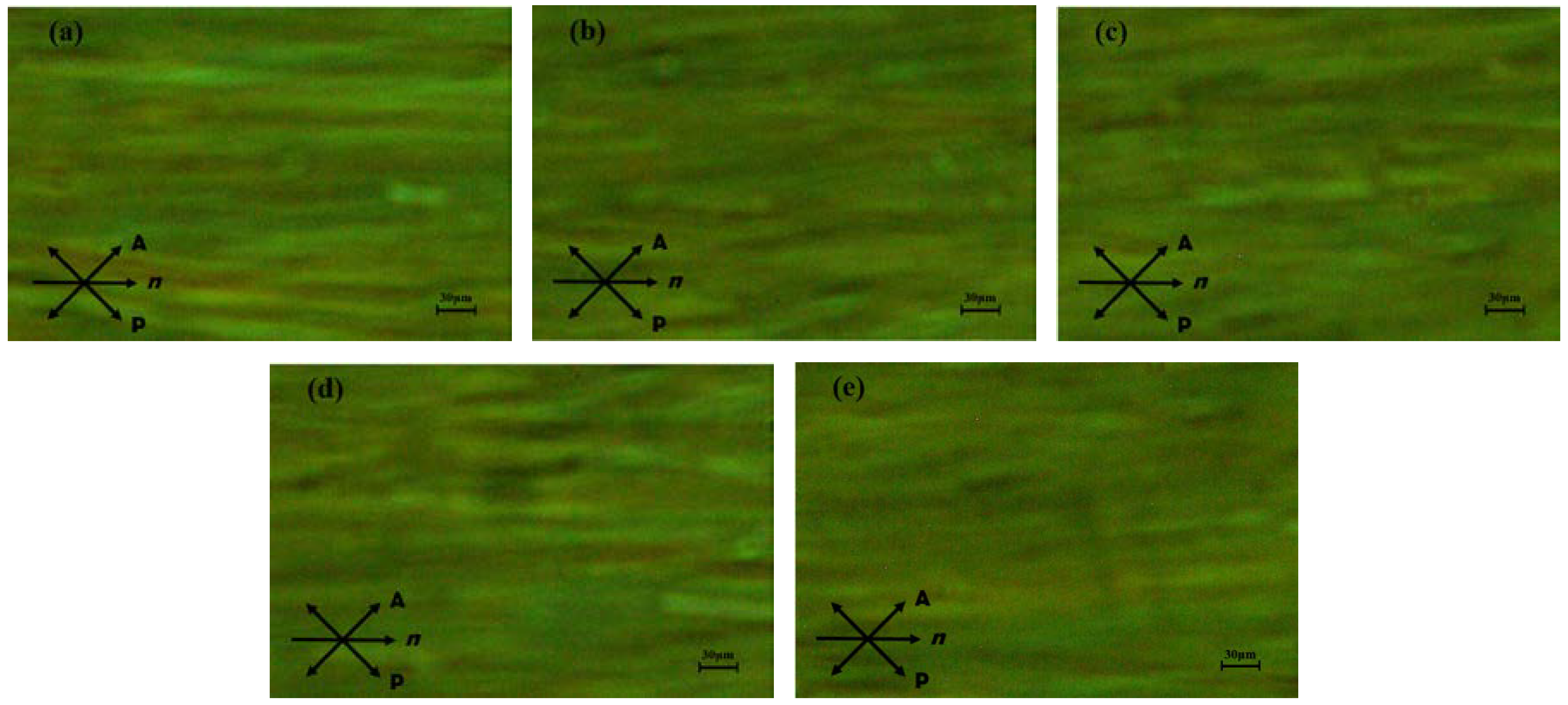



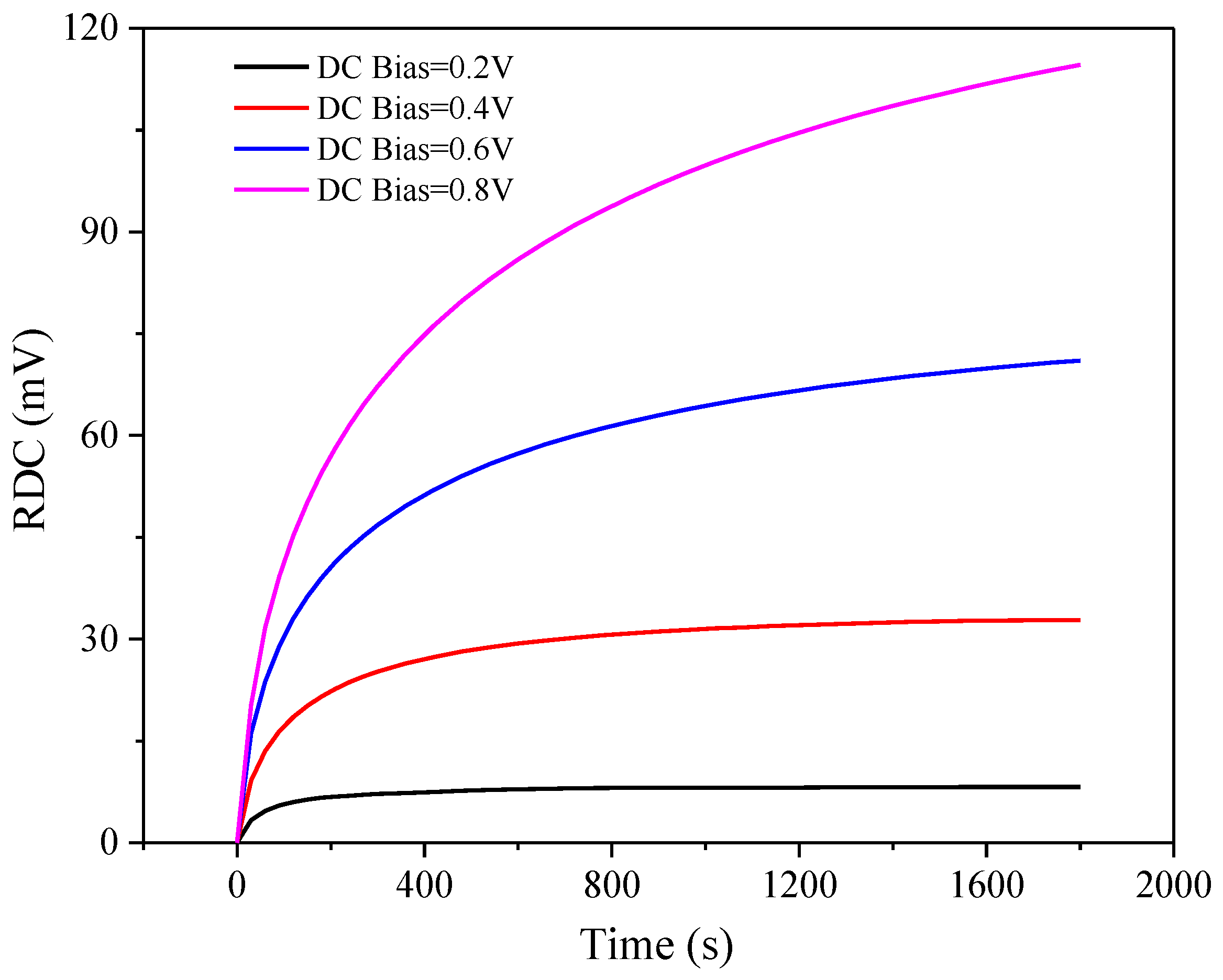
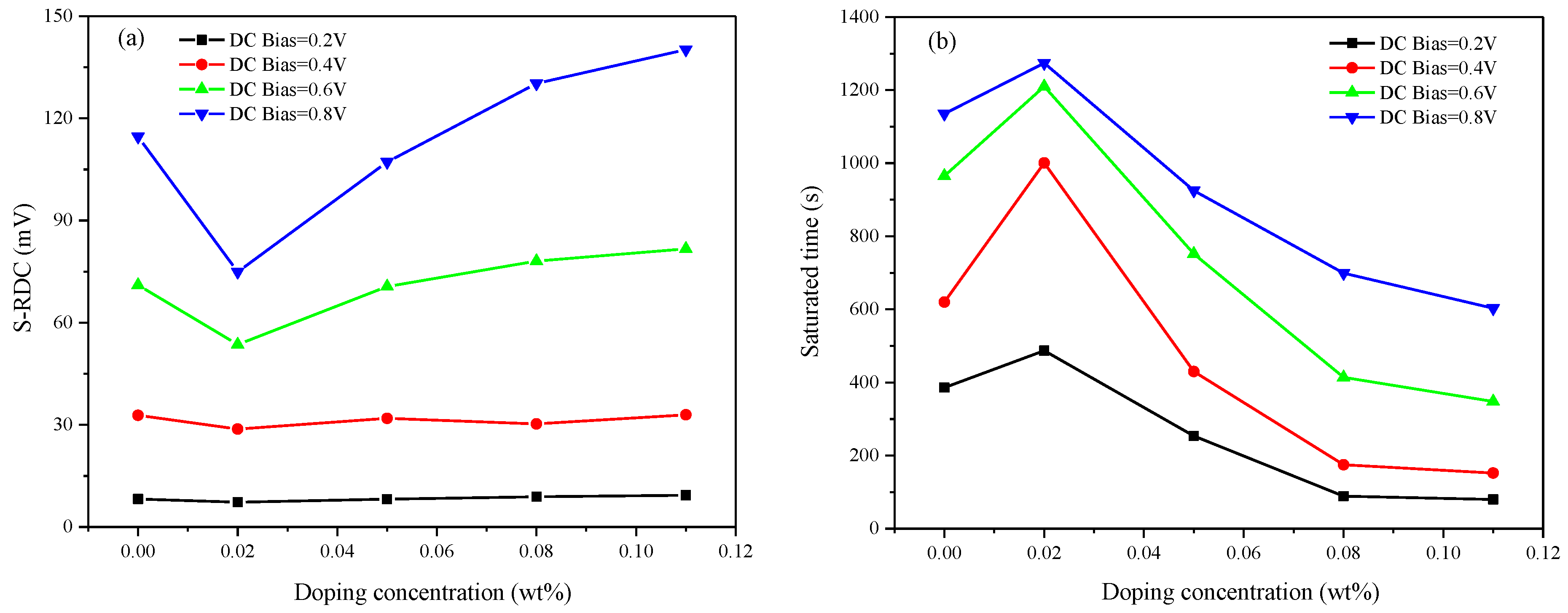

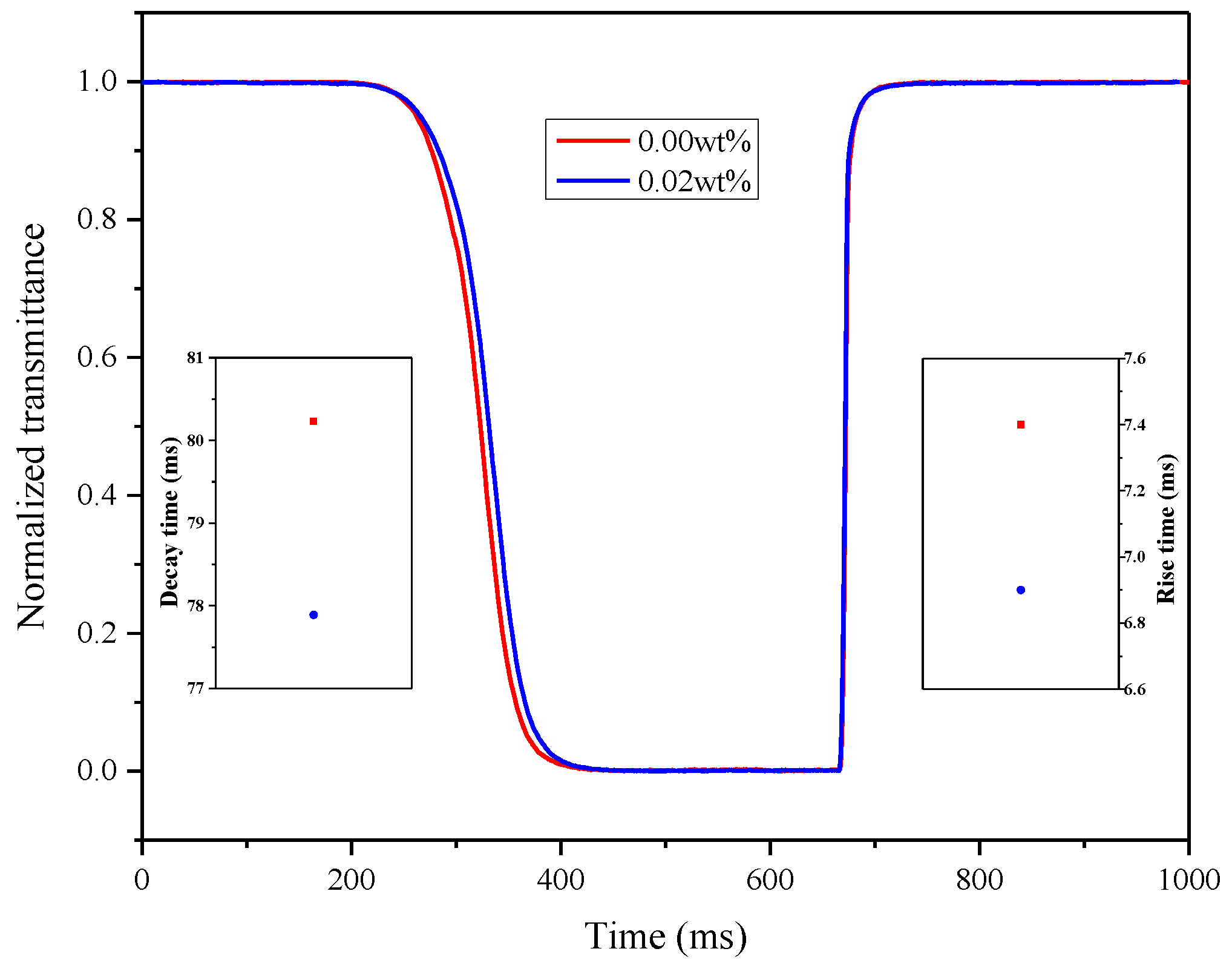
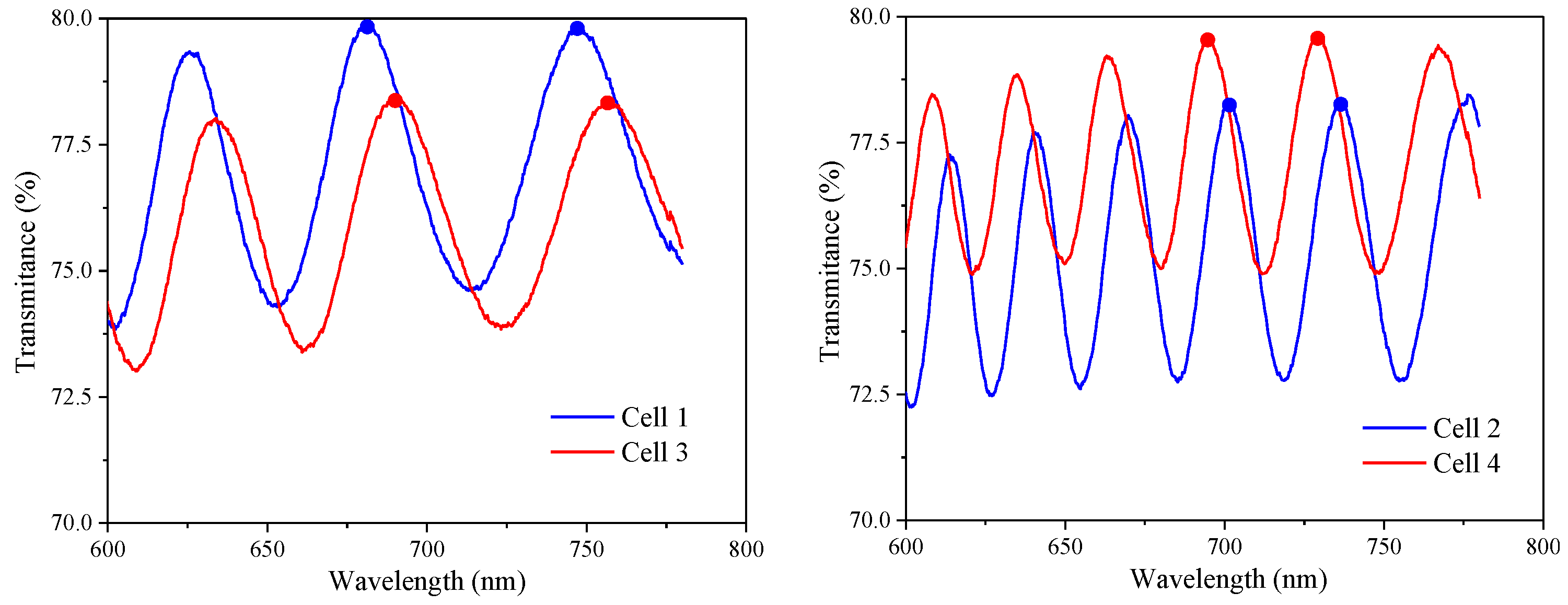


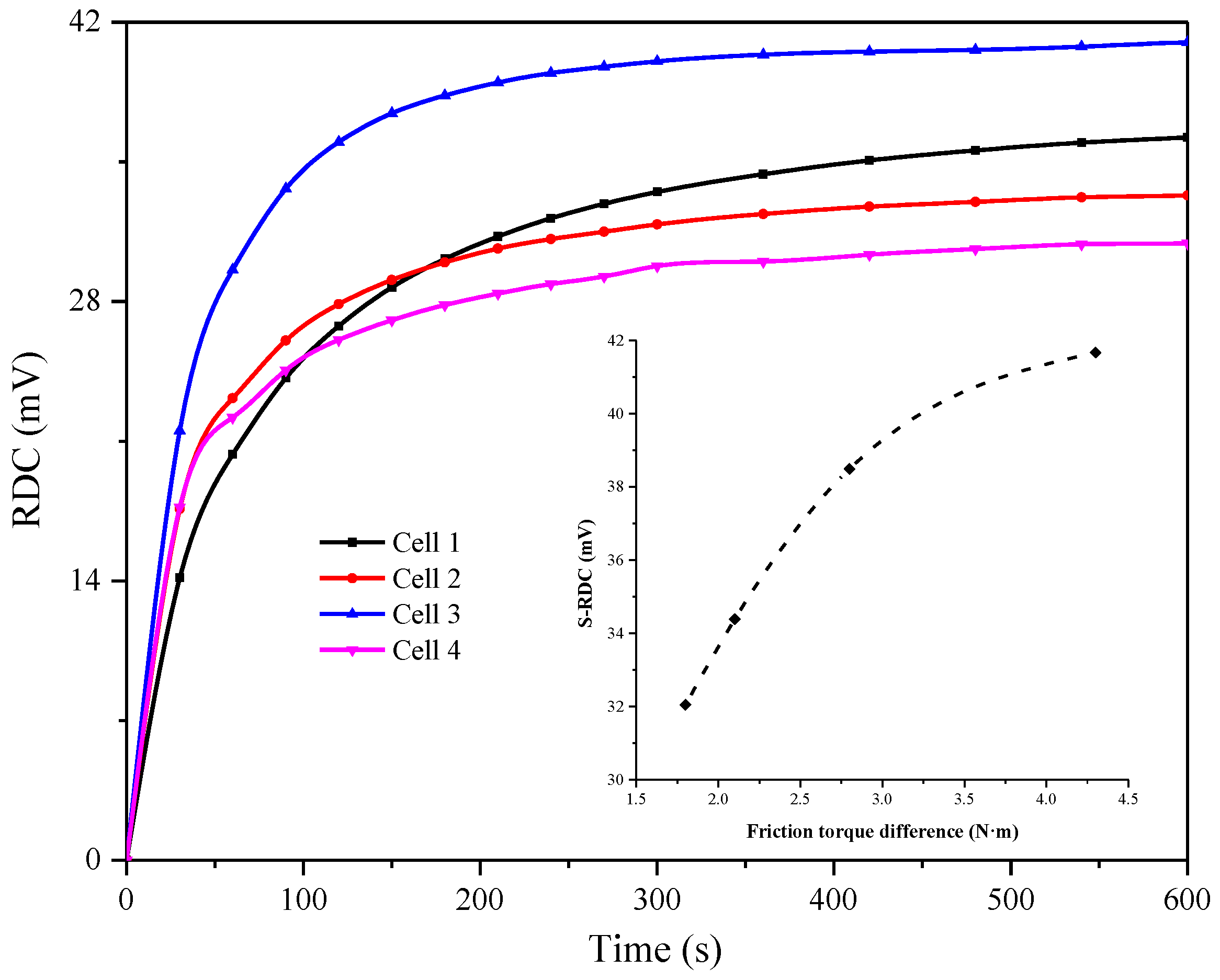
| Samples | Clear Point (°C) | Uth (V) | Δε | k11 (pN) | γ1 (mpa·s) |
|---|---|---|---|---|---|
| Undoped LC | 91.3 | 1.495 | 6.58 | 13.20 | 19.49 |
| LC + 0.02 wt% γ-Fe2O3 | 93.6 | 1.463 | 6.67 | 12.81 | 17.97 |
| LC + 0.05 wt% γ-Fe2O3 | 93.1 | 1.452 | 6.71 | 12.7 | 16.22 |
| LC + 0.08 wt% γ-Fe2O3 | 92.0 | 1.437 | 6.70 | 12.42 | 15.27 |
| LC + 0.11 wt% γ-Fe2O3 | 92.9 | 1.394 | 6.74 | 11.75 | 14.03 |
| Number | 1 | 2 | 3 | 4 |
|---|---|---|---|---|
| Cell gap/μm | 3.8 ± 0.1 | 7.4 ± 0.1 | 3.8 ± 0.1 | 7.4 ± 0.1 |
| Thickness of PI layer/nm | 60.8 | 61.7 | 61.2 | 60.7 |
| Friction torque on up substrates/N·m | 2.7 | 2.2 | 25.3 | 25.5 |
| Friction torque on lower substrates/N·m | 5.5 | 4.3 | 29.6 | 27.3 |
© 2018 by the authors. Licensee MDPI, Basel, Switzerland. This article is an open access article distributed under the terms and conditions of the Creative Commons Attribution (CC BY) license (http://creativecommons.org/licenses/by/4.0/).
Share and Cite
Gao, L.; Dai, Y.; Li, T.; Tang, Z.; Zhao, X.; Li, Z.; Meng, X.; He, Z.; Li, J.; Cai, M.; et al. Enhancement of Image Quality in LCD by Doping γ-Fe2O3 Nanoparticles and Reducing Friction Torque Difference. Nanomaterials 2018, 8, 911. https://doi.org/10.3390/nano8110911
Gao L, Dai Y, Li T, Tang Z, Zhao X, Li Z, Meng X, He Z, Li J, Cai M, et al. Enhancement of Image Quality in LCD by Doping γ-Fe2O3 Nanoparticles and Reducing Friction Torque Difference. Nanomaterials. 2018; 8(11):911. https://doi.org/10.3390/nano8110911
Chicago/Turabian StyleGao, Lin, Yayu Dai, Tong Li, Zongyuan Tang, Xueqian Zhao, Zhenjie Li, Xiangshen Meng, Zhenghong He, Jian Li, Minglei Cai, and et al. 2018. "Enhancement of Image Quality in LCD by Doping γ-Fe2O3 Nanoparticles and Reducing Friction Torque Difference" Nanomaterials 8, no. 11: 911. https://doi.org/10.3390/nano8110911
APA StyleGao, L., Dai, Y., Li, T., Tang, Z., Zhao, X., Li, Z., Meng, X., He, Z., Li, J., Cai, M., Wang, X., Zhu, J., Xing, H., & Ye, W. (2018). Enhancement of Image Quality in LCD by Doping γ-Fe2O3 Nanoparticles and Reducing Friction Torque Difference. Nanomaterials, 8(11), 911. https://doi.org/10.3390/nano8110911






